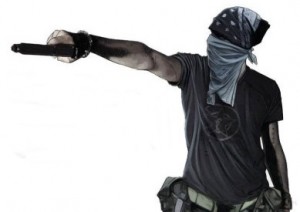Before you go dodging bullets, let’s build a profile of the most likely shooter you might run across.
While these stats are specific to a single state, they stand as a good national average when it comes to firearm types and crime. In 2009 in the state of California 2% of crimes were committed with machine guns, 7.5% with shotguns, 8.8% with rifles, and finally 81.6% with handguns. That’s right, criminals prefer hand guns, and for obvious reasons. Looking at a variety of stats from different eras the three most likely handguns to be employed are a .38, 9mm, or .22; in no particular order as it continually changes.
So standing in a store buying a Slurpee, you now know what an assailant is most likely to hold in your and the cashiers face as he demands cash. So who is perpetrating these violent crimes? A study on education vs. violent crime had this to say:
“Theory suggests several ways that educational attainment may affect subsequent criminal decisions. First, schooling increases individual wage rates, thereby increasing the opportunity costs of crime. Second, punishment is likely to be more costly for the more educated. Incarceration implies time out of the labor market, which is more costly for high earners. Furthermore, previous studies estimate that the stigma of a criminal conviction is larger for white collar workers than blue collar workers (see e.g. Kling (2002)), which implies that the negative effect of a conviction on earnings extend beyond the time spent in prison for more educated workers. Third, schooling may alter individual rates of time preference or risk aversion. That is, schooling may increase the patience exhibited by individuals (as in Becker and Mulligan (1997)) or their risk aversion. More patient and more risk averse individuals would place more weight on the possibility of future punishments. Fourth, schooling may also affect individual tastes for crime by directly affecting the psychic costs of breaking the law. (See e.g. Arrow (1997).) Fifth, it is possible that criminal behavior is characterized by strong state dependence, so that the probability of committing crime today depends on the amount of crime committed in the past. By keeping youth or the street and occupied during the day, school attendance may have long-lasting effects on criminal participation.”
There are some boring stats, but suffice to say the criminal is likely a recidivist and not highly educated or trained in the labor force; think thug with the infamous “kill shot” fire arm position. According to the Department of Defense (all the branches of service), Maximum effective range of an M9 9mm pistol is a grand total of 50 meters (54.7 yards). Once again Hollywood has been misleading, unless you are a god of firearms you will not be shooting people hundreds of yards away and always scoring a headshot; sorry untrained zombie enthusiasts.
So a trained professional is not shooting targets farther than 50 meters, and likely rarely shooting that far; why? Because short barrels means short accuracy. The bullet will likely have a slower rotation and a much slower speed, both limiting range and accuracy. How far an untrained shooter with a poor firing stance can accurately fire is anyone’s guess.
Ideally if a gunman starts firing the safest place to be is behind cover (not concealment though it is better than nothing). You can also attempt to muscle the weapon out of the perpetrators hand using a krav maga move you learned three years ago. However; most of us kick it into flight mode and run, especially if you are in the open or beyond arm’s length of the shooter. Most experts will tell you to run in a zigzag. If they are untrained or trained the odds of them hitting you seriously diminish. The shooter is dealing with recoil, breathing, heart rate, lining up his sights with a moving target, and minimal effective firearm range.
These ideas in addition to dodging bullets while running away might also be useful:
“When running while knowing the shooter is focused on and going to shoot at you, run in a zig-zag pattern, like this /\/\/\->. Moving targets are harder to hit.
If you are within 6 to 7 feet of the shooter and you see him/her starting to draw a handgun it is better that you rush in and attack him/her before they fully draw their weapon and begin shooting. (This may not seem logical but if you are in a crowd it is very likely that those around you will help you subdue the shooter, after all their lives are in danger too. Also note that within 5 meters (~15ft) target acquisition is usually inaccurate, i.e. you probably cannot be shot). If you turn away and run you’ll only be 15 to 20 feet away when the shooting starts and are much more likely to be shot because of the close range.
Your chest is the biggest target and has important organs so try to keep it covered.
If you are in plain sight of the shooter, fall flat to minimize the target, making him give up or miss multiple times.
You may want to think about having a weapon of your own in case such a situation occurs.
You can also play dead but only if you’re certain shots have been fired and have personally witnessed them.”
Jon
2009 firearms used in the commission of crimes, OFFICE OF THE ATTORNEY GENERAL, CALIFORNIA DEPARTMENT OF JUSTICE, Division of Law Enforcement, Bureau of Forensic Services
The Effect of Education on Crime: Evidence from Prison Inmates, Arrests, and Self-Reports, Lance Lochner & Enrico Moretti, Department of Economics, University of Western Ontario, UCLA, October, 2003
TECHNICAL MANUAL , UNIT AND INTERMEDIATE DIRECT SUPPORT MAINTENANCE MANUAL , PISTOL, SEMIAUTOMATIC, 9mm, M9, ARMY TM 9-1005-317-23
How to Survive a Public Shooting, Edited by Glutted, Rob S, Ben Rubenstein, Andy Zhang and 31 others


Great site. Love this article.